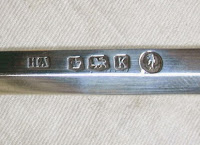Silver is a beautiful metal whose use is literally as old as the hills. Silver metalworkers developed superb levels of craftsmanship over the centuries and this ongoing skill and sophistication amongst silversmiths continues to this day.
The collector has a wide choice and can specialise by type as well as in terms of age and history. Silver from the early Georgian or even earlier periods is quite rare and therefore rather expensive. The later Georgian period is more affordable, as are the ornate and profuse Victorian wares. Always popular is silver from Arts and Crafts, Art Nouveau, and Art Deco periods.
 |
| Silver Tea Caddy |
 |
| Serving Dish |
 The collector of British silver has the advantage of the
hallmarking system where an independent assay office stamps the maker’s mark,
quality, and date on each piece of silver.
People do also like to collect the discontinued assay offices such as
Chester and Exeter. An amateur can
appear to have a little knowledge by glancing at the hallmarking guides which
really does fit into a pocket when going to the antique fairs.
The collector of British silver has the advantage of the
hallmarking system where an independent assay office stamps the maker’s mark,
quality, and date on each piece of silver.
People do also like to collect the discontinued assay offices such as
Chester and Exeter. An amateur can
appear to have a little knowledge by glancing at the hallmarking guides which
really does fit into a pocket when going to the antique fairs.
When investing in silver another advantage is that it is
a precious metal with its own value, without considering any value in the
workmanship or rarity. This can turn into a curse - when the 'scrap' price was
over £20 per ounce in 2011 many potential collectable items must have been
smelted down, a very sad occurrence.

No comments:
Post a Comment